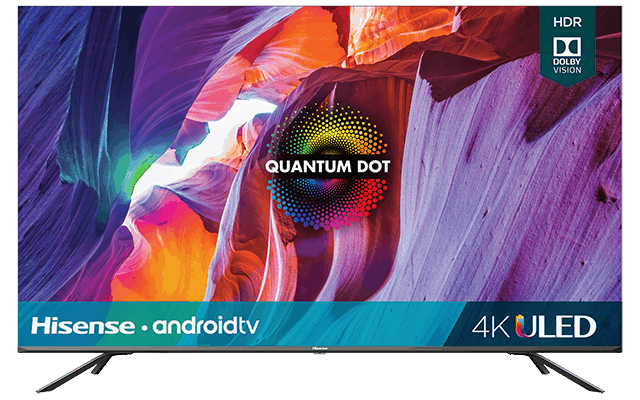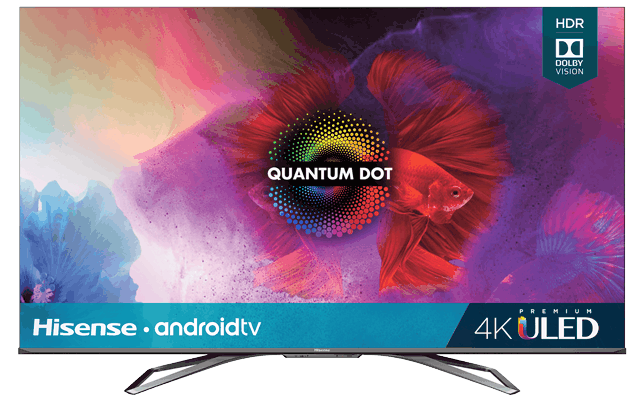At face value, the H9G is a much better Smart TV than the H8G. But, if you go into the specifics, you’ll notice that the HG8 has some impressive features and can stand its ground in this duel. We’ll compare the two TV’s key features in this Hisense H8G vs H9G comparison page to determine how they fare in a direct matchup.
Hisense H8G vs H9G – Quick Comparison
Hisense H8G

The Hisense H8G is the go-to option for many TV buyers looking for a capable all-around TV that doesn’t break the bank. It’s one of the more affordable 4K TVs on the market, and it doesn’t lack features. H8G’s biggest pros and cons are:
Pros:
- Above-average contrast ratio
- Dolby Atmos and Dolby Vision HDR
- Solid Smart TV platform
- Affordable
Cons:
- Poor viewing angles
- No VRR, FreeSync, or G-SYNC support
Hisense H9G

The Hisense H9G ticks all key boxes and makes for a top-quality TV under a thousand dollars. It features a simple design but has strong performance capabilities in every aspect that matters. Here are some of H9G’s most significant advantages and drawbacks:
Pros:
- Outstanding contrast ratio
- Impressive peak brightness
- Great reflection handling capabilities
- Phenomenal motion handling technology
Cons:
- Poor viewing angles
- No VRR, FreeSync, or G-SYNC support
Features Face to Face
Panel Technology
The two series employ the same panel technology, full-array LED backlight panels. To be more precise, these two TVs come with ULED (Ultra Light Emitting Diode) panel technology, Hisense’s in-house technology that it uses in its top-end TV sets.
This technology uses bulbs embedded at specific intervals behind the TV’s screen. In other words, it uses an opposite approach to edge-lit LED technology, which features bulbs around the screen’s edges.
Because of this layout, full-array panel technology enables TVs to produce clearer and higher-quality images than edge-lit LED TVs. Moreover, as full-array LED TVs generally feature more bulbs in their layout, they can produce brighter images than other LED classic panels.
Image Processor
The Hisense H8G and H9G both use the Hi-View™ chipset for all image processing tasks. This processor is the newest in its line available on Hisense TVs. It uses smart image processing features to automatically adjust brightness and contrast and produce the best picture quality possible.
Motion Technology
The H8G has a very good response time with almost no visible overshoot. It can fully transition between colors in just 13.7 milliseconds. Although this is very solid on its own, the H9G noticeably outperforms the H8G in this category. It offers a complete image transition time of just over eight milliseconds, much quicker than most TVs can complete this task.
Picture Quality
The two TVs offer identical performance characteristics when it comes to overall picture quality properties and supported resolutions. To better understand the scope of all supported resolutions, we’ve drafted a streamlined Hisense H8G vs H9G comparison table:
| Resolution | H8G | H9G |
|---|---|---|
| 4K/120Hz | No | No |
| 4K/60Hz/4:4:4 | Yes | Yes |
| 4K/60Hz | Yes | Yes |
| 1440p/120Hz | No | No |
| 1440p/60Hz | Yes (Forced resolution required) | Yes (Forced resolution required) |
| 1080p/120Hz | No | No |
| 1080p/60Hz/4:4:4 | Yes | Yes |
Overall, the two TVs offer a good variety of supported resolutions. However, we were disappointed that neither TV properly supports any 120Hz signals, despite featuring 120Hz panels. Moreover, to make sure you get the most out of the HDMI 2.0’s full bandwidth on either TV, you’ll need to adjust settings and set HDMI Format to the “Enhanced” option.
Contrast Ratio / Black Level
Like most VA LED panels, the H8G offers an excellent native contrast ratio, which you can additionally improve by tailoring the local dimming options. It can display deep blacks and deliver high-quality dark scenes even in a dark room.
Despite the H8G being a competent performer, the H9G is again the better option in contrast ratio. This is because it offers a much better native contrast ratio than the H8G. What’s more, when you adjust H9G’s contrast ratio with local dimming, you can enjoy much better performance than with the H8G.
Local Dimming
As we’ve mentioned above when discussing panel technology, the H8G and the H9G have a full-array backlight configuration and feature local dimming settings. The H9G offers more capable local dimming settings, as it’s much better at handling transitions. While minor details may pop up occasionally, there’s no noticeable black crush that would distract you from the viewing experience.
The H8G has decent local dimming settings and is adept in handling blooming and providing quick and reasonably seamless transitions. That said, you’ll notice that the H8G crushes small light sources, unlike the H9G.
Peak Brightness
The H9G outperforms the H8G in terms of both HDR and SDR peak brightness. That said, the H8G holds its own pretty well when it comes to the latter type, as it offers above-average SDR peak brightness numbers. However, while the H9G maintains impressive brightness in HDR, H8G’s HDR peak brightness is just okay. Check out the table below for a better overview of how the two TVs compare in this category:
| Brightness Values | H8G | H9G |
|---|---|---|
| Peak 10% Window SDR Brightness | ∼ 630 nits | ∼ 1310 nits |
| Peak 100% Window SDR Brightness | ∼ 450 nits | ∼ 580 nits |
| Peak 10% Window HDR Brightness | ∼ 620 nits | ∼ 1280 nits |
| Peak 100% Window HDR Brightness | ∼ 450 nits | ∼ 580 nits |
Color
The H8G delivers decent color volume, and you can count on it to produce deep and saturated colors. It also has excellent CI P3 color space coverage but limited coverage of the Rec 2020 color space.
The H9G has similarly limited Rec 2020 color space coverage and an excellent wide color gamut. Again, the H9G has the edge in this category as it has a noticeably better color volume than the H8G. That said, the two TVs can’t escape the weakness of most LCDs, and that’s that they can’t deliver very bright blues.
Viewing Angle
Like most VA LED panels, the H8G and the H9G are equally subpar in delivering even slightly wider viewing angles. The two TVs quickly lose their image accuracy when you move even a little bit off-center. They start showing brightness loss around 35 degrees and dark shades around 20 degrees. If you’re looking for a TV suitable for a wide seating arrangement, neither of these two is a suitable option.
Reflections / Anti-glare
The H9G offers much better reflection handling properties than the H8G. This is primarily because the H9G’s panel has a glossy finish, while the H8G has a semi-gloss finish. In other words, the H9G reflects much less light that hits its surface.
To put this into numbers, the H9G reflects less than two and a half percent of all light, while the H8G reflects almost five and a half percent. This discrepancy may not seem like a lot, but it translates to a significant performance difference, as the H8G struggles in well-lit rooms, while the H9G can perform very well, even in direct sunlight.
Sound Quality
The two TVs deliver improved sound quality compared to older Hisense models but still fail to impress. Both the H8G and the H9G have an okay frequency response and a well-balanced sound profile.
However, the H9G offers better dynamic range compression values. It’s a pivotal aspect to keep in mind if you like to push your TV close to its max volume without sacrificing dialogue quality. This is why, in a direct comparison of the two models, the H9G gets a slight edge in terms of overall sound quality.
Smart TV Platform (Operating System)
Comparing these two models’ Smart TV features doesn’t produce any differentiating results, as the H8G and the H9G use the same version of the same OS. The OS in question is the 9.0 version of the Android TV smart platform.
This operating system is not entirely on par with what other leading TV manufacturers offer but is good enough to get the job done. It’s relatively smooth and not very challenging to navigate.
The app selection is impressive, as you can take advantage of everything Android TV’s Google Play Store has to offer. You can also enjoy HDR on Netflix and YouTube, and the TVs load apps in just a couple of seconds.
Connectivity
Although the two TVs significantly differ in several features we’ve discussed above, they are identical d in terms of connectivity properties across the board. More precisely, both the H8G and the H9G offer all the connectivity properties you’d expect from a Smart TV in 2021.
Inputs
The two TVs have identical input support. Additionally, we should highlight that they offer exceptional input lag times. These two TVs even come with a “Game” option in “Picture Mode.” This enables you to get the lowest input lag possible, which is crucial for gamers who want to use either of these two TVs as a gaming monitor. Here’s a table covering the key input options of these two TVs:
| Input Ports | H8G | H9G |
|---|---|---|
| HDMI Ports | 4 HDMI 2.0 Ports | 4 HDMI 2.0 Ports |
| USB Ports | 2 USB 2.0 Ports | 2 USB 2.0 Ports |
| Digital Optical Audio Out | 1 Port | 1 Port |
| Ethernet Port | Yes | Yes |
Voice Assistants
The HG8 and the H9G come with the same Smart TV remote with plenty of voice control options. They allow you to play videos and music, change channels and volume, and take advantage of other Smart TV features, all by simply using your voice. The two TVs also work with Amazon Alexa and Google Assistant.
Wireless Technologies
The H8G and the H9G come with the same wireless technology. This includes Bluetooth support and the same Wi-Fi standards (2.4GHz and 5GHz). These features allow you to conveniently pair headphones, speakers, or any other wireless entertainment device you want to connect to your TV.
Standout Features
While neither TV has any significant standout features over the other, they both share a couple of features that help them stand out from other TVs in their price ranges. To be exact, this includes HDR10+ and HLG. These two traits make a significant performance difference when broadcasting HDR content like that found in Dolby Vision. And, speaking of Dolby Vision, both the H8G and the H9G also include this dynamic range of video technology.
Conclusion
After comparing a long list of key characteristics in this Hisense H8G vs H9G review, it’s safe to say that the latter model is clearly the better option. While the H8G is a solid performer that offers you excellent value for money, it simply can’t go toe to toe with the H9G in many crucial categories.
The H9G offers brighter colors, delivers superior reflection handling properties, has a better native contrast ratio, and more. Of course, all of these features are also accompanied by an evidently higher price tag. Ultimately, it’s up to you to decide whether you’re prepared to spend more to get a more capable TV all-around or whether you’re content with the H8G’s relatively average performance.